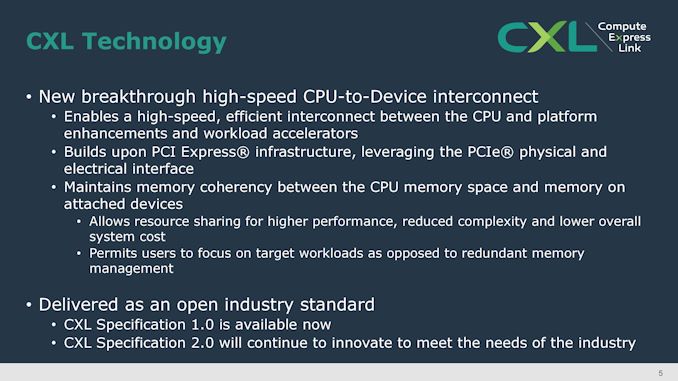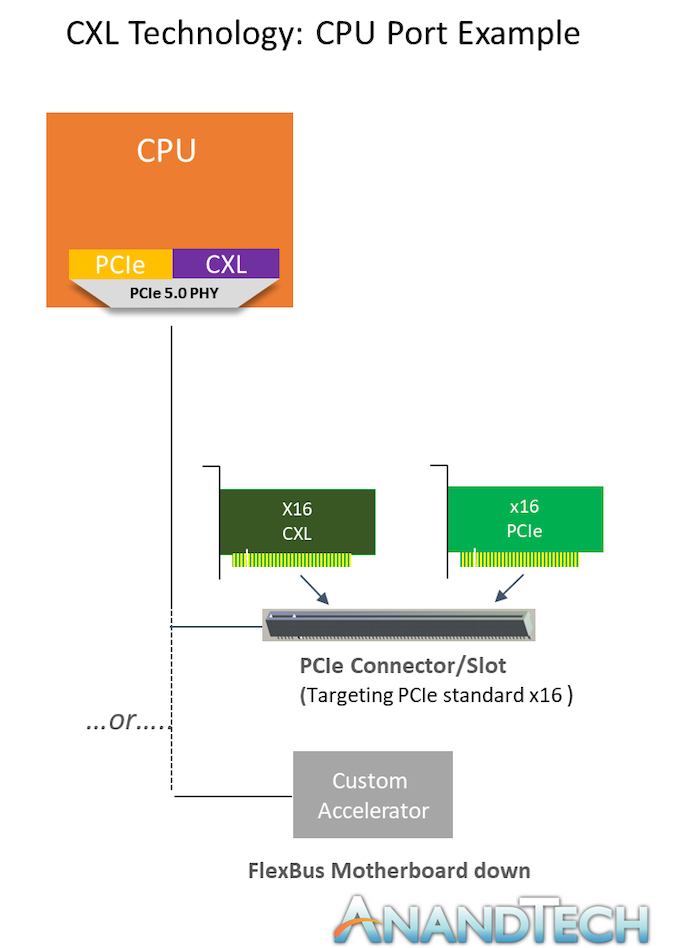Compute Express Link (CXL): From Nine Members to Thirty Three
by Dr. Ian Cutress on April 15, 2019 12:30 PM EST- Posted in
- Interconnect
- Intel
- Compute Express Link
- CXL
- PCIe 5.0

Last month the CXL Specification 1.0 was released as a future cache coherent interconnect that uses the PCIe 5.0 physical infrastructure but aimed to provide a breakthrough in utility as well as cache coherency. At the time, the to-be-defined consortium consisted of Intel and eight other founding members. Since the announcement, membership has grown from that initial nine to thirty three, including some important names in the industry.
The Future Is In Interconnect
In August 2018, in coverage of AMD’s Infinity Fabric interconnect, I stated that the battle of the future would be on the front of the interconnect. Specifically relating to CPUs at the time, I said:
After core counts, the next battle will be on the interconnect. Low power, scalable, and high performance: process node scaling will mean nothing if the interconnect becomes 90% of the total chip power.
Fast forward a year later, and interconnect is still the hot topic when it comes to future design. Not only from CPU-to-CPU, but CPU-to-Device, and Device-to-Device, the ubiquity of the interconnect and the utility that each one offers is gearing up to be a battlefield. For non-coherent interconnects, at a system level, then PCIe is still the top player, but companies involved are looking to cache coherent options, such as CCIX, GenZ, and now CXL.
Compute Express Link, known as CXL, was launched last month. A fanfare was made as the standard had been building inside Intel for almost four years, and was now set to be an open standard built upon PCIe 5.0 infrastructure, allowing devices using CXL to have the same physical connection interface. The nine initial promotors of the CXL specification included industry heavy hitters: Alibaba, DellEMC, Facebook, Google, HPE, Huawei, Intel, and Microsoft, indicating that CXL is expecting to be a big part of the chip-to-chip portfolio for these companies, and it even has the support of the GenZ consortium. An official ‘CXL consortium’ has not been registered as of yet, however it is expected to be incorporated this year, with these nine companies at the helm.
Part of the announcement last month into the CXL 1.0 specification was to encourage new participants into the CXL standard. It has been designed as an open standard, and thus companies are willing to propose adjustments to future versions of the standard as well as build upon it without any licensing fees. We’re expecting the CXL technical specifications to be open in due course, as the technology is built upon.
One of the key elements to the announcement was the founders. Nine sizeable companies, each with interests in servers and accelerators, is more than the founding members when PCIe (5) or USB (7) started. There were some key names missing, however some of them have now signed up. The full list reads as follows:
- Achronix Semiconductor Corp
- *Alibaba Group
- Arm
- Ayar Labs
- BlackFore Technologies LTD
- Cadence Design Systems
- *Cisco Systems
- *DellEMC
- DriveScale Inc.
- Eidetic Communications Inc
- Faraday Technology Company
- Fastwel Group Ltd
- GigaIO
- *Hewlett Packard Enterprise
- *Huawei
- Inspur
- *Intel
- InterOperability Laboratory
- Lenovo
- Mellanox Technologies
- Memsule Inc.
- Microchip Technology Inc
- *Microsoft
- Mobiveil, Inc
- Norel Systems LTD
- Northwest Logic
- Numascale AS
- PLDA, Inc
- SerialTek
- SK Hynix
- Synopsys
*Founding Members
The new highlights of this list include Arm, Cadence, Lenovo, Mellanox, SK Hynix, and Synopsys. Each of these companies has a high impact factor in the future of computing, either from a fundamental technical standpoint, implementation, or product line. It is interesting to note that Mellanox is a member, but NVIDIA isn’t, given that NVIDIA recently acquired the company. NVIDIA has its own NVLINK technology, however Mellanox’s product portfolio one suspects has to be open to new standards more than NVIDIA’s. Having SK Hynix as a member could be interesting for future memory offerings, and Arm as a member means that we could see any of Arm’s licensees perhaps looking into CXL technologies in the future.
As CXL 1.0 relies on PCIe 5.0, we’re going to have to wait until PCIe 5.0 comes to market before we see anything CXL related. However, a handy diagram from Intel at the CXL launch is a key one to remember regarding potential future CXL support. Intel recently held an Interconnect Day where CXL was explained in more detail. Unfortunately we were unable to attend, however we do have the slides and the notes, and will be going over them in due course.
Related Reading
Source: CXL












18 Comments
View All Comments
ksec - Monday, April 15, 2019 - link
How does Next Gen infinity Fabric compared to CXL 1.0?edzieba - Monday, April 15, 2019 - link
Being based on PCIe 5.0 rather than 4.0, CXL will effectively be double the bandwidth per lane as ngIF.ats - Monday, April 15, 2019 - link
They don't. infinity fabric isn't as open I/O standard and instead fulfills the same niche as basically Intel's QPI et al.DanNeely - Monday, April 15, 2019 - link
"Unfortunately we were unable to attend, however we do have the slides and the nodes, "nodes = notes?
Old_Fogie_Late_Bloomer - Monday, April 15, 2019 - link
Multiple video advertisements playing simultaneously is how you lose readers who can't install adblocking plugins on work computers.surt - Tuesday, April 16, 2019 - link
Not allowing the installation of ad-blocking software is how you lose valuable employees and eventually your company to more nimble competitors.Old_Fogie_Late_Bloomer - Tuesday, April 16, 2019 - link
The risk of leaking confidential information or committing an export violation is too great (it might be slim, but it's non-zero). I personally trust Adblock Plus on my personal devices (Adblock Browser single-handedly makes iOS usable for me) but a) they're a German company, b) companies get compromised, and c) plugins can potentially be compromised even if their authors are not.RU482 - Monday, April 15, 2019 - link
So....do you suppose nVidia will pull Mellanox out of the mix?ats - Monday, April 15, 2019 - link
Only if they want to flush money away. Mellanox makes the vast majority of their money off of Intel servers.rahvin - Monday, April 15, 2019 - link
On the contrary Mellanox's involvement might be why Nvidia is missing from the list. Membership likely costs a bunch of money and why would they pay it twice when they are buying a founding member. They'll just switch the name to Nvidia once the acquisition is complete.